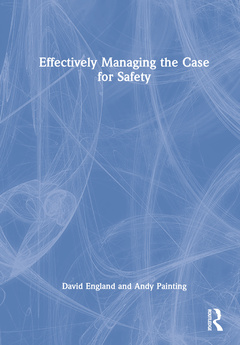Effectively Managing the Case for Safety
Auteurs : England David, Painting Andy

This book examines how safety failings during the use of any designed product or system?be it a car, a building, or a chemical plant?can be mitigated through effective understanding of the conditions and controls surrounding its use.
Drawing on historical failures and their own real-world experience, Dr Andy Painting and David England explain how corporate culture, engineering safety, personnel selection, and proper safety auditing are key ingredients to maintaining safety in all aspects of an organization?s operations. This effective strategy is also crucial to linking back to the design of future products in establishing where operational failures have been identified and can therefore be "designed out" in future iterations. The book challenges silo thinking among the various safety-related disciplines and shows how this can be counter-productive to effective safety management.
Effectively Managing the Case for Safety draws on key features from engineering, design, and health and safety processes, which, when used cohesively, promote a better working environment for everyone and help to reduce wasted time, money, and effort for any organization. Safety is tracked from the initial design stage through any product?s entire service life and includes evidence of how safety affects, and is affected by, all those who interact with a product, system, or project. Following their first book, An Effective Strategy for Safe Design in Engineering and Construction, which demonstrated how current construction regulations can be used as a framework to ensure that safety is embedded into the design of virtually any product from machinery to buildings, this follow up book defines what safe is, how it is initially derived, and how the operational safety of any product, during its in-use phase, can be managed and assessed. The result is not only to ensure compliance with relevant regulations but also to actively ensure the ongoing safety of all those who interact with a product or project.
Andy Painting began his working career in the Royal Navy serving 23 years as a submariner. As a weapons engineer, his job involved tracing and rectifying faults with various components of submarines, as well as helping to design and test new and modified weapon systems. It was during one repair task, whilst hanging upside down trying to reach a valve that needed replacement, he began to wonder if the design of critical components could be improved. Endeavouring to find an answer, he took degrees in engineering and health and safety, which led to achieving a doctorate in 2015. The thesis for this doctorate was catastrophic failure in complex systems, which led to the creation of an administrative early warning system which can predict the early failure of virtually any type of engineering installation or system.
After the Navy, he became the Chief Engineer for Her Majesty’s Naval Base at Portsmouth, where he was in charge of all the infrastructure supporting the Royal Navy’s home dockyard. This included manœuvring out of shipbuilding halls a component part of the Queen Elizabeth aircraft carrier. This brought the 600-year-old tradition of shipbuilding at Portsmouth to a close. In 2015, he left the dockyard to set up his own company providing engineering and health and safety advice to a range of clients including government, local authority, and military organizations. This advice is inherently based on an understanding of how to implement engineering solutions that reflect best practice with cost efficiency, balanced always with the safety of the end user in mind. He is a Fellow of the Safety and Reliability Society and a Chartered Engineer.
David England joined the civil service after leaving school, quickly learning administrative and management techniques as well as discovering a passion for the law. In the late 1980s he was involved in the supply and development of fibre optics which, at the time, was a nascent industry wi
Date de parution : 12-2022
17.4x24.6 cm
Date de parution : 12-2022
17.4x24.6 cm
Thèmes d’Effectively Managing the Case for Safety :
- Dessin industriel CAO FAO
- Économies et politiques économiques mondiales : relations économiques internationales / douanes, exportation
- Construction
- Santé publique / médecine du sport / médecine légale
- Génie mécanique / conception / calculs (assistés par ordinateur)
- Fiabilité, essais / entretien et maintenance / contrôle qualité
- direction / stratégie d'entreprise
Mots-clés :
Construction; construction safety; process safety; process auditing; engineering safety; waste reduction; reducing waste; preventing failures; improving safety; through-life safety; safety cases; hazard management; golden thread; safety case reporting; safety metrics; risk management; Coda; Safety Case; Follow; Accident Investigation; Feedback; Event Tree Analyses; Greiner's Model; Swiss Cheese; Safety File; Job Safety Analysis; Tonnes; Ceo; AAIB; Document Management System; Circuit Courts; HSE; Tours; Control Measures; Organization's Risk Register; PDSA; Potential Water Line; UK Road; FRAM



